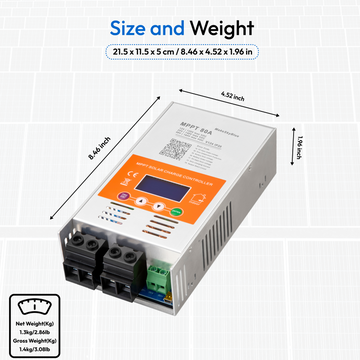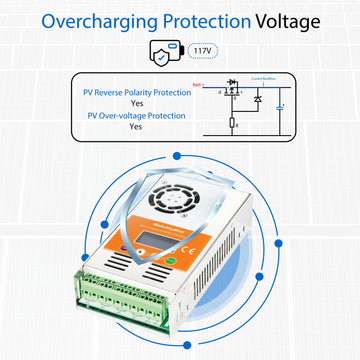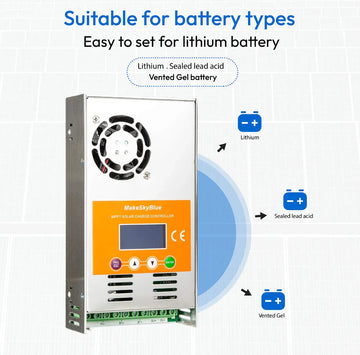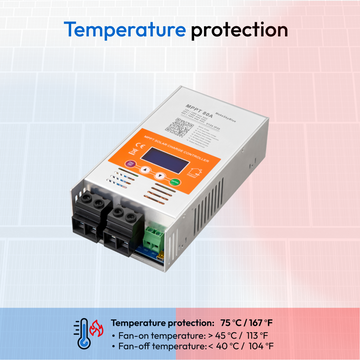There is a lot of confusion in selecting the ideal equipment to use in your solar power system. Moreover, choosing an 100 amp charger controller is one of the best choices to avail the stable accumulation of energy and preservation of the battery. This blog completely covers all the details of these powerful devices.
In this modern world, solar energy systems keep gaining popularity. Consequently, it is necessary to know how charge controllers operate to anyone planning to invest in renewable energy. A 100 amp solar charge controller is normally used to control the current coming out of your solar panels into your batteries. In addition, it eliminates over charging and increases battery duration considerably.
What Makes a 100 Amp Solar Charge Controller Essential?
A 100 amp solar charge controller serves as the brain of your solar power system. It is basically a voltage controller that is intended to control the voltage and current passing through solar panels to batteries. It also prevents the damage of your expensive battery bank that occurs due to overcharging or over-discharging.
Battery protection remains the primary function of any charge controller. Meanwhile, the device monitors battery voltage constantly. Subsequently, it adjusts charging rates based on battery condition and solar panel output.
How Does a 100 Amp Solar Charge Controller Work?
Understanding the working mechanism helps you maximize system performance. Initially, solar panels generate DC electricity when sunlight hits them. Then, this electricity flows toward the charge controller.
The controller analyzes incoming voltage and current levels. Consequently, it determines the optimal charging parameters for your batteries. Modern controllers use advanced algorithms for this process. Moreover, they adapt to changing weather conditions throughout the day.
According to the U.S. Department of Energy, proper charge management increases battery lifespan by 30 to 50 percent.[1] Therefore, investing in quality equipment pays off quickly through reduced replacement costs.
Types of Solar Charge Controllers Available
Two main technologies dominate the market currently. First, PWM controllers offer basic functionality at lower prices. Second, MPPT controllers provide superior efficiency through advanced tracking.
PWM Charge Controllers
PWM stands for Pulse Width Modulation technology. Essentially, these controllers create a direct connection between panels and batteries. Meanwhile, they pull panel voltage down to battery voltage levels.
This technology works well for small systems. However, it wastes excess voltage that could otherwise charge batteries faster. Consequently, PWM controllers typically show 75 to 80 percent efficiency.
MPPT Charge Controllers for Better Performance
MPPT means Maximum Power Point Tracking technology. Notably, these controllers harvest 20 to 30 percent more energy than PWM versions.[2] Additionally, they operate panels at optimal voltage regardless of battery voltage.
The BettSun 100A MPPT solar charge controller from MakeSkyBlue exemplifies modern MPPT technology. Furthermore, it includes WiFi connectivity for remote monitoring and control. Subsequently, users can track system performance from their smartphones.
MPPT controllers convert excess voltage into additional charging current. Therefore, batteries charge faster and more completely. This efficiency becomes especially important during cloudy weather or early morning hours.
Key Features to Look for in a 100 Amp Solar Charge Controller
Several critical features determine controller quality and performance. First, voltage compatibility must match your battery bank configuration. Second, the controller should support multiple battery types including lithium and lead-acid.
WiFi connectivity offers tremendous convenience for modern users. Moreover, cloud-based monitoring lets you check system status anywhere. MakeSkyBlue controllers provide these advanced features at competitive prices.
Multiple protection features safeguard your investment effectively. These include overcharge protection, reverse polarity protection, and short circuit protection. Furthermore, quality controllers prevent over-discharge that damages batteries permanently.
Benefits of Using a 100 Amp MPPT Solar Charge Controller
MPPT technology delivers measurable advantages over traditional PWM controllers. First, energy harvest increases by 10 to 45 percent depending on conditions.Second, faster battery charging means more usable power available.
System flexibility improves dramatically with MPPT technology. For example, you can connect higher voltage solar arrays to lower voltage battery banks. Subsequently, this reduces wiring costs and voltage drop over long distances.
Cold weather performance remains consistently strong with MPPT controllers. Meanwhile, PWM controllers struggle when temperatures drop significantly. Therefore, MPPT becomes essential for installations in northern climates.
Sizing Your Solar System with a 100 Amp Charge Controller
Proper sizing ensures optimal performance and prevents equipment damage. First, calculate your solar array's maximum current output. Then, add a 25 percent safety factor for unexpected increases.
A 100 amp solar charge controller typically handles 1200 to 1400 watts on a 12V system. Moreover, it manages 2400 to 2800 watts on 24V systems and 4800 to 5600 watts on 48V systems. Therefore, voltage selection significantly impacts total system capacity.
Professional installation ensures safety and optimal performance. However, experienced DIY users can install controllers successfully by following manufacturer guidelines carefully. MakeSkyBlue provides detailed installation manuals with their products.
Comparing 100 Amp Solar Charge Controllers
|
Feature |
PWM Controller |
MPPT Controller (MakeSkyBlue BettSun) |
|
Efficiency |
75-80% |
93-97% |
|
Cold Weather Performance |
Moderate |
Excellent |
|
Voltage Flexibility |
Limited |
High |
|
Price Range |
Lower |
Moderate |
|
Energy Harvest |
Standard |
20-30% More |
|
Remote Monitoring |
Rarely |
WiFi Included |
|
Battery Type Support |
Limited |
Multiple Types |
|
System Voltage |
Must Match |
Flexible |
Installation Best Practices for Maximum Safety
Safety must remain the top priority during installation. First, disconnect all power sources before beginning work. Second, follow local electrical codes strictly. Third, use appropriately sized wiring for current levels.
Mount controllers in well-ventilated locations away from direct sunlight. Additionally, protect them from moisture and extreme temperatures. Subsequently, this extends equipment lifespan significantly.
Wire connections must be tight and secure. Moreover, use proper crimping tools for terminal connections. Loose connections create resistance that generates dangerous heat.
Maintenance Tips for Long-Term Performance
Regular maintenance keeps your 100 amp solar charge controller operating efficiently. First, inspect connections quarterly for signs of corrosion or looseness. Second, clean dust from ventilation openings monthly.
Monitor system performance through your controller's display or app. Meanwhile, watch for unusual voltage readings or error messages. Subsequently, address problems immediately to prevent damage.
Firmware updates improve controller performance and add new features. Therefore, check manufacturer websites periodically for available updates. MakeSkyBlue releases regular updates for their WiFi-enabled controllers.
Common Problems and Troubleshooting Solutions
Understanding common issues helps you resolve problems quickly. First, low charging rates often indicate dirty solar panels or shading problems. Second, error codes provide specific information about system faults.
Communication problems with WiFi controllers require checking network settings. Furthermore, verify your router allows device connections and operates on compatible frequencies. MakeSkyBlue support team provides excellent technical assistance when needed.
Battery not charging completely suggests incorrect settings or battery problems. Therefore, verify battery type selection matches your actual batteries. Subsequently, check voltage settings align with manufacturer specifications.
Advanced Features in Modern 100 Amp Controllers
Technology advances bring impressive capabilities to modern controllers. First, cloud connectivity enables monitoring from anywhere globally. Second, historical data tracking reveals system performance trends. Programmable charging profiles optimize performance for specific battery types. Moreover, users can customize settings based on seasonal requirements. Subsequently, this flexibility maximizes energy harvest throughout the year.
Load control outputs power DC equipment directly from the controller. Additionally, programmable timers automate lighting and other loads. Therefore, system functionality extends beyond simple battery charging. Parallel operation capability allows connecting multiple controllers together. Consequently, this expands system capacity easily as energy needs grow. MakeSkyBlue offers controllers specifically designed for parallel operation.
Environmental Impact and Sustainability
Solar power systems reduce carbon emissions significantly compared to fossil fuels. Moreover, proper equipment maximizes the environmental benefits of renewable energy. A 100 amp solar charge controller ensures efficient energy use throughout system operation.
Extended battery life through optimal charging reduces electronic waste. Consequently, fewer batteries end up in landfills over time. Additionally, efficient energy harvest reduces the number of panels needed.
Government incentives encourage solar adoption worldwide. Furthermore, many regions offer rebates for battery storage systems. Therefore, investing in quality charge controllers becomes even more affordable.
Conclusion
The choice of 100 amp solar charge controller has significant effects on the performance and reliability of the system. In addition, the new MPPT technology has a better efficiency level than the older PWM controllers. MakeSkyBlue provides the great choices between the high-tech options with reasonable prices.
The future of sustainable energy production is solar power. Consequently, it is extremely economical to spend money on quality parts such as professional-grade charge controllers. Afterward, your system provides you with stable power with a much lesser impact on the environment.
Go to MakeSkyBlue to see their entire collection of solar charge controllers and accessories. We offer a variety of products including a 100 amp solar charge controller and any other product cater requirement of your system.
FAQs
What size solar array works with a 100 amp charge controller?
A 100 amp controller handles approximately 1200-1400 watts at 12V, 2400-2800 watts at 24V, and 4800-5600 watts at 48V systems. Therefore, system voltage significantly affects total capacity.
Can I use a 100 amp controller with lithium batteries?
Yes, modern controllers like MakeSkyBlue BettSun support both lithium and lead-acid batteries. Moreover, they offer programmable charging profiles for different battery chemistries.
Do I need WiFi connectivity on my charge controller?
WiFi connectivity provides convenient remote monitoring and control. However, basic controllers function perfectly well without this feature. Nevertheless, WiFi adds significant value for tech-savvy users.
Can I connect multiple 100 amp controllers in parallel?
Some controllers support parallel operation for increased capacity. However, verify manufacturer specifications before attempting parallel connections. MakeSkyBlue offers models specifically designed for this purpose.
What causes a charge controller to fail prematurely?
Common causes include lightning strikes, incorrect wiring, overheating, and moisture damage. Therefore, proper installation and protection prevent most failures effectively.




